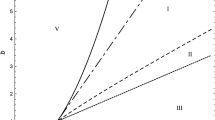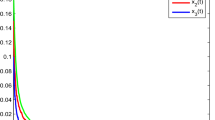Abstract
A spatial predator–prey model with colored noise is investigated in this paper. We find that the number of the spotted pattern is increased as the noise intensity is increased. When the noise intensity and temporal correlation are in appropriate levels, the model exhibits phase transition from spotted to stripe pattern. Moreover, we show the number of the spotted and stripe pattern, with respect to both noise intensity and temporal correlation. These studies raise important questions on the role of noise in the pattern formation of the populations, which may well explain some data obtained in the ecosystems.
Similar content being viewed by others
References
Baurmann, M., Gross, T., Feudel, U.: Instabilities in spatially extended predator–prey systems: spatio-temporal patterns in the neighborhood of Turing–Hopf bifurcations. J. Theor. Biol. 245, 220–229 (2007)
Medvinsky, A.B., Petrovskii, S.V., Tikhonova, I.A., Malchow, H., Li, B.-L.: Spatio-temporal complexity of plankton and fish dynamics in simple model ecosystems. SIAM Rev. 44, 311–370 (2002)
Sun, G.-Q., Jin, Z., Liu, Q.-X., Li, L.: Pattern formation induced by cross-diffusion in a predator–prey system. Chin. Phys. B 17, 3936–3941 (2008)
Sun, G.-Q., Jin, Z., Liu, Q.-X., Li, L.: Dynamical complexity of a spatial predator–prey model with migration. Ecol. Model. 219, 248–255 (2008)
Murray, J.D.: Mathematical Biology. Springer, Berlin (1989)
Garvie, M.R.: Finite-difference schemes for reaction–diffusion equations modeling predator–prey interactions in Matlab. Bull. Math. Biol. 69, 931–956 (2007)
Garvie, M.R., Trenchea, C.: Finite element approximations of spatially extended predator–prey interactions with the Holling type II functional response. Numer. Math. 107, 641–667 (2007)
Holling, C.S.: Resilience and stability of ecological systems. Ann. Rev. Ecolog. Syst. 4, 1–23 (1973)
Folke, C., Carpenter, S.R., Walker, B., Scheffer, M., Elmqvist, T., Gunderson, L.H., Holling, C.: Regime shifts resilience, and biodiversity in ecosystem management. Annu. Rev. Ecol. Evol. Syst. 35, 557–581 (2004)
Richter, O.: Spatio-temporal patterns of gene flow and dispersal under temperature increase. Math. Biosci. 218, 15–23 (2009)
Scheffer, M., Rinaldi, S., Kuznetsov, Y.A., van Nes, E.H.: Seasonal dynamics of daphnia and algae explained as a periodically forced predator–prey system. Oikos 80, 519–532 (1997)
Scheffer, M., Rinaldi, S.: Minimal models of top-down control of phytoplankton. Freshw. Biol. 45, 265–283 (2000)
Guttal, V., Jayaprakash, C.: Impact of noise on bistable ecological systems. Ecol. Model. 201, 420–428 (2007)
García-Ojalvo, J., Sancho, J.M.: Noise in Spatially Extended Systems. Springer, New York (1999)
Horsthemke, W., Lefever, R.: Noise-Induced Transitions. Springer, Berlin (1984)
Lesmes, F., Hochberg, D., Morán, F., Pérez-Mercader, J.: Noise-controlled self-replicating patterns. Phys. Rev. Lett. 91, 238301 (2003)
Gammaitoni, L., Hanggi, P., Jung, P., Marchesoni, F.: Stochastic resonance. Rev. Mod. Phys. 70, 223–287 (1998)
Vilar, J.M.G., Sole, R.V.: Effects of noise in symmetric two-species competition. Phys. Rev. Lett. 80, 4099 (1998)
Scheffer, M., Carpenter, S., Foley, J., Folke, C., Walker, B.: Catastrophic shifts in ecosystems. Nature 413, 591–596 (2001)
Giardina, I., Bouchaud, J.P., Mezard, M.: Proliferation assisted transport in a random environment. J. Phys. A, Math. Gen. 34, L245–252 (2001)
Staliunas, K.: Spatial and temporal noise spectra of spatially extended systems with order–disorder phase transitions. Int. J. Bifurc. Chaos Appl. Sci. Eng. 11, 2845–2852 (2001)
Bjornstad, O.N., Grenfell, B.T.: Noisy clockwork: time series analysis of population fluctuations in animals. Science 293, 638–643 (2001)
Mantegna, R.N., Spagnolo, B.: Stochastic resonance in a tunnel diode. Phys. Rev. E 49, R1792–R1795 (1994)
Mantegna, R.N., Spagnolo, B.: Noise enhanced stability in an unstable system. Phys. Rev. Lett. 76, 563–566 (1996)
Spagnolo, B., Fiasconaro, A., Valenti, D.: Noise induced phenomena in Lotka–Volterra systems. Fluct. Noise Lett. 3, L177–L185 (2003)
Valenti, D., Fiasconaro, A., Spagnolo, B.: Stochastic resonance and noise delayed extinction in a model of two competing species. Physica A 331, 477–486 (2004)
Braza, P.A.: The bifurcation structure of the Holling–Tanner model for predator–prey interactions using two-timing. SIAM J. Appl. Math. 63, 889–904 (2003)
Collings, J.B.: Bifurcation and stability analysis of a temperature-dependent mite predator–prey interaction model incorporating a prey refuge. Bull. Math. Biol. 57, 63–76 (1995)
Hsu, S.B., Huang, T.W.: Global stability for a class of predator–prey systems. SIAM J. Appl. Math. 55, 763–783 (1995)
Wollkind, D.J., Collings, J.B., Logan, J.A.: Metastability in a temperature-dependent model system for predator–prey mite outbreak interactions on fruit flies. Bull. Math. Biol. 50, 379–409 (1988)
May, R.M.: Stability and Complexity in Model Ecosystems. Princeton University Press, Princeton (1973)
Reichenbach, T., Mobilia, M., Frey, E.: Noise and correlations in a spatial population model with cyclic competition. Phys. Rev. Lett. 99, 238105 (2007)
Reichenbach, T., Mobilia, M., Frey, E.: Mobility promotes and jeopardizes biodiversity in rock–paper–scissors games. Nature 448, 1046–1049 (2007)
Liu, Q.-X., Li, B.-L., Jin, Z.: Resonance and frequency-locking phenomena in a spatially extended phytoplankton–zooplankton system with additive noise and periodic forces. J. Stat. Mech. Theory Exp. 5, P05011 (2008)
Blasius, B., Huppert, A., Stone, L.: Complex dynamics and phase synchronization in spatially extended ecological systems. Nature 399, 354–359 (1999)
Mankin, R., Ainsaar, A., Haljas, A., Reiter, E.: Trichotomous-noise-induced catastrophic shifts in symbiotic ecosystems. Phys. Rev. E 65, 051108 (2002)
Mankin, R., Sauga, A., Ainsaar, A., Haljas, A., Paunel, K.: Colored-noise-induced discontinuous transitions in symbiotic ecosystems. Phys. Rev. E 69, 061106 (2004)
Sun, G.-Q., Li, L., Jin, Z., Li, B.-L.: Effect of noise on the pattern formation in an epidemic model. Num. Methods Partial Differ. Equ. 26, 1168–1179 (2010)
Higham, D.J.: An algorithmic introduction to numerical simulation of stochastic differential equations. SIAM Rev. 43, 525–546 (2001)
Petrovskii, S., Li, B.L., Malchow, H.: Transition to spatiotemporal chaos can resolve the paradox of enrichment. Ecol. Complex. 1, 37–47 (2004)
Malchow, H., Petrovskii, S.V., Venturino, E.: Spatiotemporal Patterns in Ecology and Epidemiology: Theory, Models, and Simulations. Chapman & Hall/CRC, London (2008)
Sun, G.-Q., Jin, Z., Li, L., Liu, Q.-X.: The role of noise in a predator–prey model with allee effect. J. Biol. Phys. 35, 185–196 (2009)
Sun, G.-Q., Zhang, G., Jin, Z., Li, L.: Predator cannibalism can give rise to regular spatial pattern in a predator–prey system. Nonlinear Dyn. 58, 75–84 (2009)
Freund, J.A., Schimansky-Geier, L., Beisner, B., Neiman, A., Russell, D.F., Yakusheva, T., Moss, F.: Behavioral stochastic resonance: how the noise from a daphnia swarm enhances individual prey capture by juvenile paddlefish. J. Theor. Biol. 214, 71–83 (2002)
Sun, G.-Q., Liu, Q.-X., Jin, Z., Chakraborty, A., Li, B.-L.: Influence of infection rate and migration on extinction of disease in spatial epidemics. J. Theor. Biol. 264, 95–103 (2010)
Tanner, J.T.: The stability and the intrinsic growth rates of prey and predator populations. Ecology 56, 855–867 (1975)
Author information
Authors and Affiliations
Corresponding author
Rights and permissions
About this article
Cite this article
Li, L., Jin, Z. Pattern dynamics of a spatial predator–prey model with noise. Nonlinear Dyn 67, 1737–1744 (2012). https://doi.org/10.1007/s11071-011-0101-8
Received:
Accepted:
Published:
Issue Date:
DOI: https://doi.org/10.1007/s11071-011-0101-8




